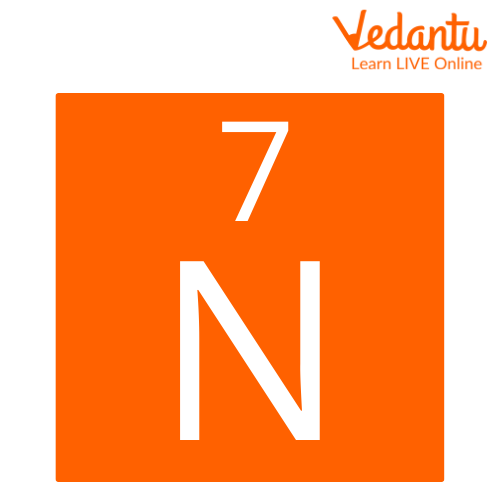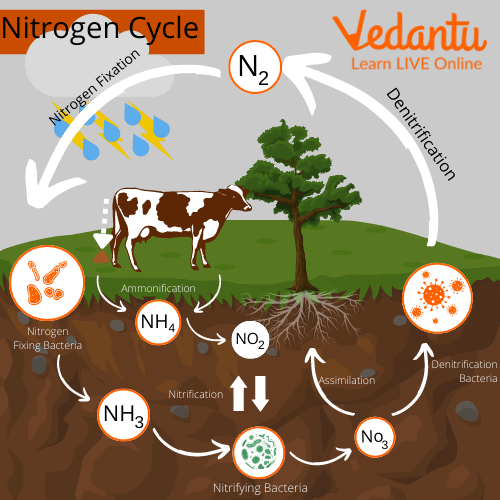




A Brief Introduction to Nitrogen: Discovery, Uses and Interesting Facts
The first element in column 15 of the periodic table is nitrogen. The class of "other" non-metal elements includes it. Seven electrons, seven protons, and five electrons in the outer shell make up the nitrogen atom.

Symbol of Nitrogen
Through the nitrogen cycle, nitrogen has a significant impact on the survival of plants and animals on earth. A nitrogen molecule has a mass of 28 units since it is made up of two bonded atoms. The majority of the air in the earth's atmosphere is made up of the gas nitrogen (important gas), an element of chemistry. N represents nitrogen as a symbol.
Who Discovered Nitrogen?
Now, we might have some questions like who is the discoverer of nitrogen? Or who found nitrogen? Daniel Rutherford, a Scottish chemist, isolated nitrogen for the first time in 1772. "Noxious air," he referred to the gas as nitrogen. French chemist Jean-Antoine Chaptal gave nitrogen its name in 1790. When he discovered that nitre contained the gas, he gave it the name nitre. Other names for nitrate include saltpetre and potassium nitrate.
Even though we frequently refer to the air we breathe as "oxygen," nitrogen is the most prevalent element. Nitrogen gas makes up 78 percent of the Earth's atmosphere. The Earth's crust has extremely little nitrogen despite the high nitrogen content of the atmosphere. Some relatively uncommon minerals, like saltpetre, include it. All living things on Earth, including plants and animals, have nitrogen. In both proteins and nucleic acids, it is crucial.
Interesting Facts about Nitrogen
The following are some interesting facts about Nitrogen. Other nitrogen compounds exist in the air, rain, soil, and ocean.
Liquid nitrogen is extremely cold and will instantly cause frostbite and severe damage to flesh upon contact.
It is estimated to be the universe's eighth most abundant element in terms of mass.
In terms of mass, nitrogen makes up the fourth most of the elements in the human body. About 3% of the mass of the human body is made up of it.
Fusion, a process that takes place deep inside stars, creates it.
In DNA molecules, nitrogen plays a vital role.
Nitrogen has two stable isotopes, 14 and 15, respectively. Nitrogen-14 makes up more than 99 per cent of the universe's nitrogen.

Nitrogen Cycle
Nitrogen Uses
Making ammonia is nitrogen's main industrial usage. The Haber’s Process, in which nitrogen and hydrogen are mixed to produce ammonia, is the method by which nitrogen is used to manufacture ammonia (ammonia). After that, ammonia makes explosives, nitric acid, and fertilisers. Nitrogen is a component of several explosives, including TNT, nitroglycerin, and gunpowder.
Nitrogen gas is used in incandescent light bulbs, producing stainless steel, preserving fresh food, decreasing fire threats, and other processes. To keep things cold, liquid nitrogen is utilised as a refrigerant. Additionally, it is employed in the cryopreservation of blood and biological materials. Liquid nitrogen is frequently used by scientists in low-temperature science research.
Summary
With the atomic number 7 and the chemical symbol N, nitrogen is a gaseous chemical element. It is a tasteless, odourless, colourless gas that makes up 78 per cent of the atmosphere on earth and it is a component of all living things. It can be used as an inert atmosphere or dilute other gases because it is the almost completely inert diatomic molecule N2. Free nitrogen is also present in many meteorites, the gases from mines, volcanoes, and some mineral springs, as well as some stars and nebulae, in addition to the air.
FAQs on How Many Atoms Does Nitrogen have?
1. How many atoms does nitrogen have?
Chemical element nitrogen has an atomic number of seven (it has seven protons in its nucleus). Two nitrogen atoms are securely linked together to form the chemical molecule known as molecular nitrogen. At average temperatures and pressures, molecular nitrogen is a colourless, odourless, tasteless, and inert gas. Nitrogen makes up about 78% of the atmosphere on earth. Molecular nitrogen is a molecule that is practically inert due to the strong triple-bond that connects its atoms. But when nitrogen bonds do break, the ensuing substances are frequently very reactive.
2. How many atoms of nitrogen are in NH3 and what is the atomic mass of ammonia?
NH3 is a chemical compound known as ammonia. It is composed of one nitrogen atom and three hydrogen atoms. The atomic mass of ammonia is 17.03.
3. What are the properties of nitrogen?
Nitrogen is a colourless, odourless, and tasteless gas. It is one of the most abundant elements found on earth. Nitrogen is also vital for life and a major component of air. It has a molecular weight of 28.02 g/mol and an atomic symbol of N. Nitrogen forms many compounds with other elements. Some of the examples are amides, ammonia, nitrates, hydrazine, urea, etc.









